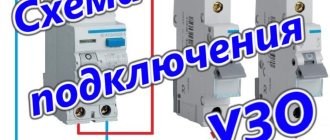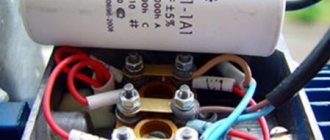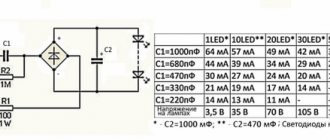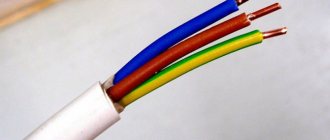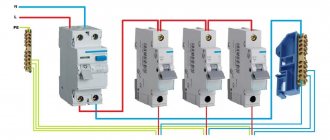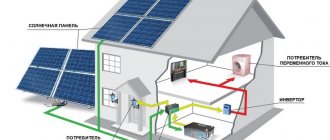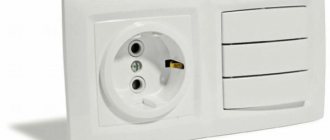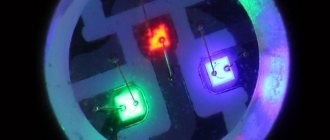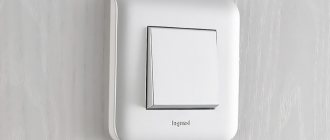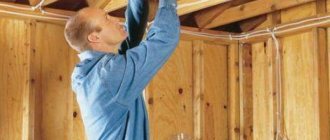One of the main tasks of the indoor electrical network is to ensure the safety of people and the safety of electrical appliances. The presence of residual current devices (RCDs) in the network does not guarantee complete safety; they only protect against voltage surges and short circuits.
But if you choose the right protective devices and think through the circuit diagram for connecting the RCD, then the level of protection will be maximum. In this article you will learn how to correctly connect an RCD to an existing power supply circuit.
Purpose and operating principle of RCD
The operation of the residual current device is based on a constant comparison of the current values that flow through the phase and neutral conductors. If you touch a live wire, some of the current will pass through the human body. Almost instantly (0.2-0.4 seconds) the RCD trips and cuts off the current, because the values of the phase and zero currents are unequal.
Installation of heated electric floors: types, power calculations, pitch
An RCD will not only save you from electric shock, but also prevent fires. If the insulation is damaged, current leakage begins. At the point of current leakage, heating occurs and the wiring may catch fire. If there is a shutdown protection device in the circuit, this situation is impossible.
If your apartment currently does not have a security device, we recommend purchasing one. How to connect an RCD before or after the machine, what other types of protective devices exist, we will consider further.
RCD selection
So what should you choose? Installation of RCD + automatic or difavtomatic? The first option is cheaper, and the second takes up less space in the electrical room. There is one more advantage in favor of the first option. If one of the devices fails, replacement will be cheaper. To properly protect your electrical network, you need to select the correct parameters of protective devices. Let's take a look at how they differ and what is right for you.
You may be interested in the article “Soldering polypropylene pipes: temperature table, installation instructions + top best pp systems” Go>>
Selection by parameters
Based on sensitivity, RCDs are divided into two types:
- protect against electric shock;
- fire protection
For the first type, the current value is set, taking into account that a current of 50 mA is dangerous for humans.
The choice also depends on the room in which the protection device is used.
Choose from two types:
- At 10 mA, if the room has high humidity (bathtub, kitchen, swimming pool, bathroom), for connecting washing machines and boilers.
- At 30 mA, if the room conditions are normal.
It is not recommended to install an RCD with a sensitivity of less than 10 mA; there is a high probability of false shutdown.
The fire-fighting type of RCD according to the current value is divided into:
- 100 mA;
- 200 mA;
- 300 mA.
Selection by type
Let's decide on the second parameter. According to the type of current leakage, they are divided into the following classes:
- AC - alternating current. Suitable for apartments, they can be connected to: warm electric floors, refrigerators and freezers, boilers, electric heating devices.
- A - for alternating and rectified (pulsating) current. Suitable for devices with switching power supplies or rectifiers. These are televisions, computers, microwaves, dishwashers and washing machines.
- B - suitable for any current, but are not used in the house.
We also pay attention to the delay time before shutdown. Suitable for home and apartment without delay. Response time from 2 ms to 3 ms.
If you have decided on the choice of protective devices, then move on to connecting them to the network.
What is a difavtomat and how does it differ from an RCD?
If we talk about how a difavtomat differs from the previous device, then it is necessary to take into account its combination with a circuit breaker. After all, in fact, a differential circuit breaker is a combination of these two devices only in a single housing.
This device performs the following functions:
- protects against current leakage;
- prevents excessive loads on the line;
- Immediately cuts off power in the event of a short circuit.
Difavtomats are universal devices
Despite the fact that the device is miniature, it works in seconds, but only if it is well assembled by a reliable manufacturer. On its body you can find basic markings that will help you make your choice.
Here, as on the RCD body, the load/leakage current is indicated, which is measured in mA.
Some users may think that the creation of a difavtomat should be a reason to stop using the machine and RCD. Nevertheless, both options remain in demand today.
Prices for various types of automatic machines
Difavtomat
Video - Which is better RCD or differential circuit breaker?
RCD diagram in a single-phase voltage network
Today, many manufacturers of household appliances recommend using protective devices when installing electrical wiring. It is advisable to additionally secure such household appliances as: washing machine, boiler, dishwasher. If we take into account that a modern electrical network in an apartment consists of several circuits designed for different loads, then there will also be several options for placing an RCD in the circuit.
Installation of electrical wiring in a wooden house
For apartments and private houses, a single-phase network is most often used. There are two possible wire options:
- With two wires. One wire is phase, the other is neutral. Which wire is which can be determined using a simple tester in the form of a screwdriver. The light on the phase wire will light up. This is an old Soviet design.
- Three wires: phase, neutral and ground. This is a modern design that came to us from abroad.
Let's consider popular circuits for connecting RCDs in a single-phase network.
Scheme without grounding
In the case when the house has single-phase electrical wiring without grounding and a simple connection diagram for all devices, i.e. there are no separate circuits for lighting, sockets, and household appliances. Then, for protection, one common RCD is used for all devices.
Connecting an RCD to an electrical circuit is not difficult. It is necessary to connect the protection device to the wires that enter the apartment or house. When connecting, observe polarity.
The phase wire is to terminal L, and the neutral wire is to terminal N. In this case, it is recommended to use an RCD with a sensitivity of 30 mA and a load of 25 A.
The disadvantage of this scheme is the difficulty of determining a leak in the network when an RCD is triggered. But this is a very simple and inexpensive way to protect electrical appliances.
Circuit with ground wire
If the apartment or house uses single-phase electrical wiring with grounding, then connecting the RCD to the network is similar to the previous option. The same type of RCD is used and the connection is made in the same way. The phase wire is to terminal L, and the neutral wire is to terminal N. The ground wire (yellow-green) is not used.
The diagram shows the connection of an RCD in a single-phase network with grounding.
Connecting an RCD with grounding
In modern apartments and private houses, specialists today use electrical wiring with grounding. Together with RCDs, other protection devices are used: circuit breakers, voltage relays.
Depending on the number of household appliances, lighting fixtures, the presence of a swimming pool, saunas, the electrical network circuit has many circuits. Therefore, the installation of an RCD and its position in the circuit depends on many factors.
Let's consider several options for such connections.
General RCD at input
If the house or apartment is small and the wiring is in good condition, then you can use the simplest RCD connection diagram. Installation of the RCD in the circuit is mounted at the input.
Connecting an RCD at the input
This connection has a number of advantages:
- not expensive;
- easy to install;
- does not require changes in the electrical network;
- takes up little space.
You may be interested in the article “How to connect a washing machine yourself: step-by-step installation instructions” Go>>
But there are also disadvantages:
- if a leak occurs, the entire house will lose power;
- it is not possible to separate electrical appliances by leakage current;
- false shutdowns may occur;
- Finding the problem area becomes difficult.
General input RCD and single-phase meter
Connection diagram for RCD with single-phase meter:
Connecting an RCD after the meter
The following connection diagram is more often found in a private home. If everything is done correctly, then there is a common machine in front of the electricity meter.
In this case, the RCD is connected after the meter. If the meter is in a special sealed box, then we connect the RCD to the wires that come out of it. The phase wire is to terminal L, and the neutral wire is to terminal N.
When you connect directly to the terminals of the electric meter, be careful. You may be fined for incorrect connection.
Connection to the meter:
- connect the second terminal to terminal L;
- the fourth with terminal N.
Introductory and group RCD with electric meter
Connecting protection at the input and for each group
This connection is the safest and most practical. During major renovations or construction, such a scheme is often used today. Let's consider how to connect the RCD in this case.
The entire electrical network of the house is divided into separate circuits. Each of these circuits is controlled by a separate protection group - RCD + AB. A common RCD is also connected to the circuit. We get double protection against current leakage.
Another advantage of this connection scheme is that it is much easier to determine the current leakage when the protection is triggered. The search is narrowed down to devices in the same circuit.
To prevent simultaneous shutdown of the general RCD and in the circuit, it is necessary to correctly select the shutdown time and current values.
If a shutdown still occurs, it means that there are problems with the RCD in one of the circuits:
- out of order;
- with marriage;
- the load is not selected correctly.
The disadvantages of this scheme are the large workload of the electrical panel and its high cost.
Only group RCD networks
This connection option is also found. The only difference from the previous scheme is the absence of a common RCD. This scheme is also quite reliable.
Of course, in such a connection we rely on the reliable operation of one device. Therefore, you should not skimp on protection devices and purchase them from reliable manufacturers.
Correct connection of a 2-pole automatic circuit breaker without grounding and with it
If there is grounding in a single-phase three-wire network, it is not connected to the protection device.
In old 220V networks there is no grounding, but this does not negate the importance of installing a protection device. The neutral and phase wires are connected to it, coming from above and leaving from below. The order of connection does not matter, but a phase must be supplied to the switches, and zero to the lamps. This is necessary for safety when replacing lamps. In addition, energy-saving and LED lamps, in the circuit of which the switch breaks zero, begin to blink. The power supplies of these light sources contain a capacitor, the charge of which causes flashes of light.
Connecting a 3-phase network
A three-phase network is not found in apartments. It can be found in a private home. Woodworking machines, lathes, and high-power engines are connected to it.
The connection diagram for a three-phase RCD differs only in the number of pins in the device. A three-pole RCD has 8 outputs: 4 incoming L1, L2, L3 and N and the same number of outgoing. To avoid getting tangled in wires when connecting, use the wire designations from the following table:
| Russian designations | European designations | ||
| Phase A | Yellow | L1 | Brown |
| Phase B | Green | L2 | Black |
| Phase C | Red | L3 | Grey |
| Neutral wire | Blue (cyan) | N | Blue (cyan) |
| Ground wire | P.E. | Green-yellow | |
Let's consider two connection options.
General RCD for 3-phase network and group RCDs
The 380V network uses 4 wires: 3 phase and one neutral. The RCD must be connected to the input three-pole circuit breaker, observing the markings.
The wires after the introductory RCD are connected to group circuit breakers. Each phase wire is connected to a single-pole RCD, and the neutral wire is taken from the common bus.
General RCD on a 3-phase network diagram:
General RCD for 3-phase network with meter
This connection diagram is practically no different from the previous one. The only difference is that the circuit has an electric meter. Group RCDs are also connected to separate power lines.
Connection diagram for an RCD in a three-phase network with a meter:
How to choose 380 volts - 2 options
In private houses, garages and workshops, three-phase voltage 380V is found. In this case there are two options:
- If there is a three-phase load, such as electric motors, only a three-phase RCD is installed. Installing three single-phase devices will lead to the disconnection of one of the phases and failure of the electric motors.
- In the absence of three-phase consumers, it is advisable to install three single-phase RCDs, one for each phase. In this case, the activation of the protection will lead to the shutdown of only one group of loads. The rest of the wiring will remain live.
Basic mistakes
When installing protection devices on their own, people often make mistakes that can lead to trouble.
These include the following incorrect actions:
- Incorrect connection of wires to the terminals of the devices. To avoid problems, we use the rule: the input phase and zero are connected to the upper terminals of the device. To the lower terminals are the wires going into the house.
- Incorrect bus connection to group circuit breakers. It must be connected above the RCD and AB groups; the circuit it protects must be isolated.
- The zeros of different groups are confused.
- Error when choosing the rated current for the protection device; it must be selected with a margin. For example, for RCD 63, AB 50A is suitable.
- When installing the socket, do not connect the yellow wire (ground) to zero.
- The neutral and ground buses are confused; different buses are used for the two conductors. The number of such tires is equal to the number of RCDs.
Always follow the connection diagram and keep it in front of you.
Safety rules for installing RCD meters and automatic machines
When connecting protection devices, a number of safety regulations must be observed. Not only does this help ensure proper connections, but it will also save your life.
How to properly connect RCDs and circuit breakers, basic rules for safe installation:
- Start work only after completely turning off the power. The presence of current in the network can be checked using a tester or a regular test light.
- Label the connected wires. Use colored electrical tape or special heat-shrinkable tubes of different colors for this.
- Connect and extend wires using special terminal blocks, clamps, and sleeves.
- After connecting the wire to the machine or other device, check the reliability of the connection. Try pulling out the wire. The next day after installing the panel, tighten all the screws again.
- Be careful when connecting power for the first time. Short circuits and sparks are possible. Stay away from the control room.
- Test the protection device by pressing the “test” button.
- Do not use heating or water supply pipes in the apartment for grounding.
Answers to 5 Frequently Asked Questions
- Is it enough to connect only the phase wire? No, this will trigger the device.
- Is it necessary to install a voltage relay along with the device? Yes, these devices protect against various factors. They are not interchangeable.
- Do you need an introductory machine to work? Yes, the device protects people from electric shock. A circuit breaker protects against overload and short circuit.
- Is there a device that combines the functions of an RCD and a circuit breaker? Yes, this is a differential machine.
- What is better - a differential circuit breaker or an RCD? A differential machine takes up less space, but is more expensive than these devices separately.
Installation instructions
Before installation, you first need to select a location for installation. For installation work, use a metal or plastic cabinet. They come in different sizes; you need to count the number of devices in advance to choose the right size.
Some models are equipped with viewing windows for taking meter readings.
How to correctly connect RCDs and machines yourself, basic rules:
- We begin any work after turning off the power supply.
- When installing wiring and protective devices, strictly follow the selected diagram; it is better to keep it in front of you.
- Connect wires strictly by color marking. Strip the ends of the wires by 0.5 cm and secure with screws.
- All protective devices, circuit breakers, voltage relays are mounted on a DIN rail. To fix them, engage the upper clamp, use a screwdriver to bend the lower clamp and press on the device, when it is in place, release the lower clamp.
- Label all protective devices on the panel so that you know which devices are connected through them.
- The machine is connected to the input wires first, only after it are all other devices installed.
- When choosing an input RCD, we calculate its parameters depending on the current flowing in the network. For example, for a current of 20-25 amperes, you should take a 32A protective disconnect device.
You might be interested in the article “Installing a toilet with your own hands: step-by-step connection instructions” Go>>
If a false shutdown occurs or the device does not work on the contrary, the reason may be the following:
- phase and neutral wires are connected after the RCD;
- check whether the neutral wire is secured;
- the neutral wire and ground are connected in the socket;
How to check an RCD in 30 seconds
After the installation of the RCD and circuit breaker connection diagram has been completed, it is necessary to check the operation of the protective devices. To check the operation of the RCD, press the button. If the power turns off when pressed, then everything is in order and the device is working. It is recommended to perform such a check periodically to ensure the operation of the device.
The second method is not recommended to be used independently. It is used by professionals. The phase, through a resistor, is connected to the ground wire. In this way, a controlled leakage of current is carried out.
It is not always possible to use the services of a professional electrician, and you have to do the work yourself. In this case, remember and strictly follow the safety rules.
We have looked at several basic schemes for connecting protective devices; in practice there can be much more.
If you are professionally involved in electrical installation work and can give useful advice or suggest other connection diagrams, write to us in the comments.
